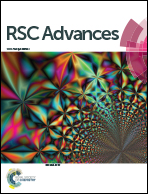Effective utilization of magnetic nano-coupled cloned β-xylanase in saccharification process
Abstract
The β-xylanase gene (DCE06_04615) with 1041 bp cloned from Thermotoga naphthophila was expressed into E. coli BL21 DE3. The cloned β-xylanase was covalently bound to iron oxide magnetic nanoparticles coated with silica utilizing carbodiimide. The size of the immobilized MNPs (50 nm) and their binding with β-xylanase were characterized by Fourier-transform electron microscopy (FTIR) (a change in shift particularly from C–O to C–N) and transmission electron microscopy (TEM) (spherical in shape and 50 nm in diameter). The results showed that enzyme activity (4.5 ± 0.23 U per mL), thermo-stability (90 °C after 4 hours, residual activity of enzyme calculated as 29.89% ± 0.72), pH stability (91% ± 1.91 at pH 7), metal ion stability (57% ± 1.08 increase with Ca2+), reusability (13 times) and storage stability (96 days storage at 4 °C) of the immobilized β-xylanase was effective and superior. The immobilized β-xylanase exhibited maximal enzyme activity at pH 7 and 90 °C. Repeated enzyme assay and saccharification of pretreated rice straw showed that the MNP-enzyme complex exhibited 56% ± 0.76 and 11% ± 0.56 residual activity after 8 times and 13 times repeated usage. The MNP-enzyme complex showed 17.32% and 15.52% saccharification percentage after 1st and 8th time usage respectively. Immobilized β-xylanase exhibited 96% residual activity on 96 days' storage at 4 °C that showed excellent stability.



 Please wait while we load your content...
Please wait while we load your content...